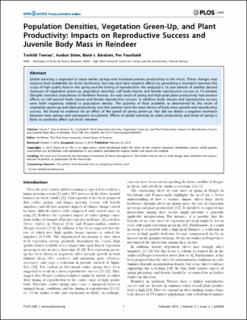Population densities, vegetation green-up, and plant productivity: impacts on reproductive success and juvenile body mass in reindeer
Peer reviewed, Journal article
Published version

Åpne
Permanent lenke
https://hdl.handle.net/11250/3076642Utgivelsesdato
2013Metadata
Vis full innførselSamlinger
- Publikasjoner fra CRIStin - NINA [2364]
- Scientific publications [1392]
Originalversjon
10.1371/journal.pone.0056450Sammendrag
Global warming is expected to cause earlier springs and increased primary productivity in the Arctic. These changes may improve food availability for Arctic herbivores, but may also have negative effects by generating a mismatch between the surge of high quality food in the spring and the timing of reproduction. We analyzed a 10 year dataset of satellite derived measures of vegetation green-up, population densities, calf body masses and female reproductive success in 19 reindeer (Rangifer tarandus) populations in Northern Norway. An early onset of spring and high peak plant productivity had positive effects on calf autumn body masses and female reproductive success. In addition, body masses and reproductive success were both negatively related to population density. The quantity of food available, as determined by the onset of vegetation green-up and plant productivity over the summer were the main drivers of body mass growth and reproductive success. We found no evidence for an effect of the speed of spring green-up. Nor did we detect a negative mismatch between early springs and subsequent recruitment. Effects of global warming on plant productivity and onset of spring is likely to positively affect sub-Arctic reindeer. Population densities, vegetation green-up, and plant productivity: impacts on reproductive success and juvenile body mass in reindeer
